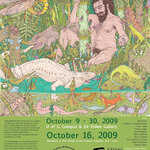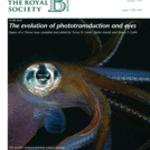Evolution

Scientists at a research institute in Austria are trying to figure out how life might evolve under different biochemistry conditions and with exotic solvents than what would exist on a world similar to Earth - think sulphuric acid instead of water.
Traditionally, planets that might sustain life are looked for in a ‘habitable zone’ - the region around a star in which Earth-like planets with carbon dioxide, water vapor and nitrogen atmospheres could maintain liquid water on their surfaces.
Scientists have been looking for biomarkers produced by extraterrestrial life with metabolisms resembling…

To the list of special issues dealing with the evolution of eyes (E:EO, Phil Trans R Soc B), you can now add one on nervous systems in Nature Reviews Neuroscience.
Nature Reviews Neuroscience
Vol. 10, Oct. 2009
Charles Darwin's theory of descent with modification by means of natural selection has stood the test of time, with new discoveries in genetics and the mathematical basis of natural selection providing ever growing evidence for the theory. This focus issue of Nature Reviews Neuroscience — sponsored by the Wellcome Trust — celebrates the contribution of Darwin's ideas to our current…

Where does evolution leave God? This question has been debated for over a century, and it likely isn't going anywhere any time soon. Some may feel, myself included, that the glut of fighting among the camps should just be put to rest, like the new song on the radio that is played every five minutes. One is about science, one is about religion. Over and done.
Occasionally I'll come across an article that still sparks my interest (like the many on Scientific Blogging, of course). One such article was an essay featured in the Wall Street Journal, in the vein of point/counter-point, but neither…

Like many institutions, the University of Guelph is hosting a series of events in celebration of the 200th anniversary of Darwin's birth and the 150th anniversary of the publication of the Origin of Species. Two of them, a teachers' workshop and the Yodzis Colloquium, have already run, but there is another coming up that I am pleased to announce.
This View of Life: Evolutionary Art for the Year of Darwin
University of Guelph and Ed Video
Oct. 9 - 30
Reception Oct. 16, 5:00-7:00pm Science Complex Atrium
Admission is free
Click poster for larger view
‘This View of Life’ showcases the melding…

A mystery of evolution is why an extra chromosome can be common across plants and animals yet have such drastically different results. A human with an extra chromosome may have Down syndrome while a cat may just be a male Calico. And plants may not only not have a negative effect, it may be downright beneficial
Polyploidy is the condition of having three, four, or more sets of chromosomes instead of the two present in diploids, like people. In plants, the process of polyploidy sometimes results in a new species, making it an important mechanism in evolution. Cotton,…

An international team of researchers say they have discovered a blueprint for a general understanding of the evolution of the "machinery" of our cells providing more evidence, at the molecular level, in support of one of the key tenets of Darwin's Theory of Evolution.
A non-Darwinian explanation, from believers of Intelligent Design, proposed these complex machines to be "irreducibly complex". In other words they are so neatly complex and complete that they couldn't have evolved but rather must have been designed by an intelligent entity.
"Our cells, and the cells of all organisms, are…

I sometimes get asked if non-coding elements (usually "junk DNA" is what they say) can ever evolve into genes. I usually say that transposable elements, at least, can be coopted into functional roles, and that it wouldn't be so odd if a pseudogene took on a novel function sometime through mutations. Kind of a lame answer, I know, but there haven't been too many unambiguous examples yet, so cut me some slack.
Anyway, here's a story in New Scientist that describes a report of three genes unique to humans that appear to have arisen from non-coding DNA. I don't know about other researchers,…

Some of you already will know about the special issue of Evolution: Education and Outreach on the evolution of eyes that I edited last year (see below). There is now another excellent collection of papers on this subject in Philosophical Transactions of the Royal Society B, edited by eye experts Trevor D. Lamb, Detlev Arendt, and Shaun P. Collin.
The evolution of phototransduction and eyes
edited by Trevor D. Lamb, Detlev Arendt, and Shaun P. Collin
Philosophical Transactions of the Royal Society B, vol. 364, issue 1531, Oct. 19, 2009
The evolution of phototransduction and eyes
Trevor D.…

One of Doug Futuyma's great quotes is this one:
"...no biologist today would think of publishing a paper on ‘new evidence for evolution’... it simply hasn’t been an issue in scientific circles for more than a century." - Futuyma, 1998 Evolution Biology, 3rd edition
Press officers are a different story. Here's one from the University of California, Riverside:
Molecular decay of enamel-specific gene in toothless mammals supports theory of evolution
Biologists at the University of California, Riverside report new evidence for evolutionary change recorded in both the fossil record and the…

I have updated the free Darwin Matrix wallpaper that is available at Evolver Zone. You can find it in different desktop sizes over at EZ.